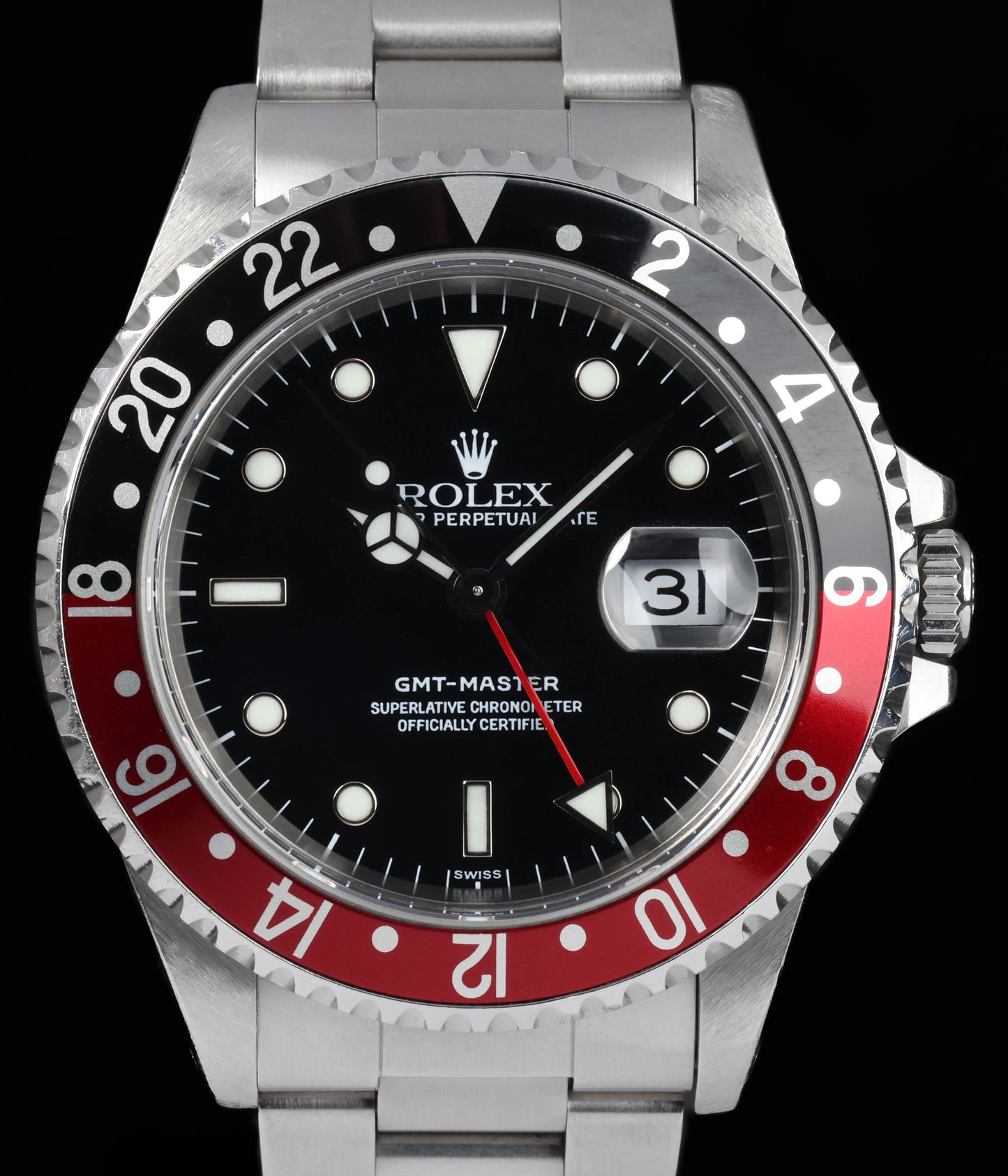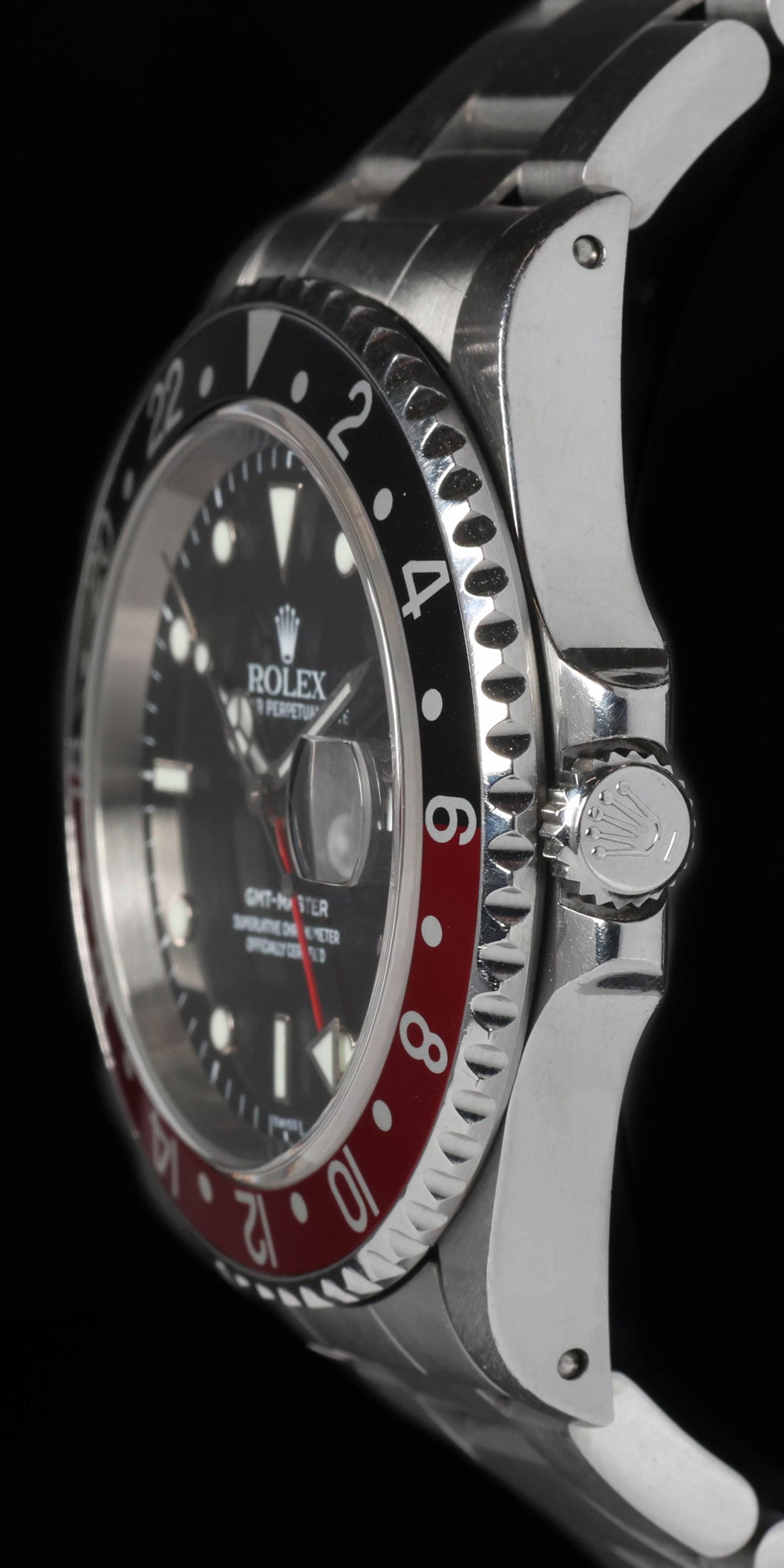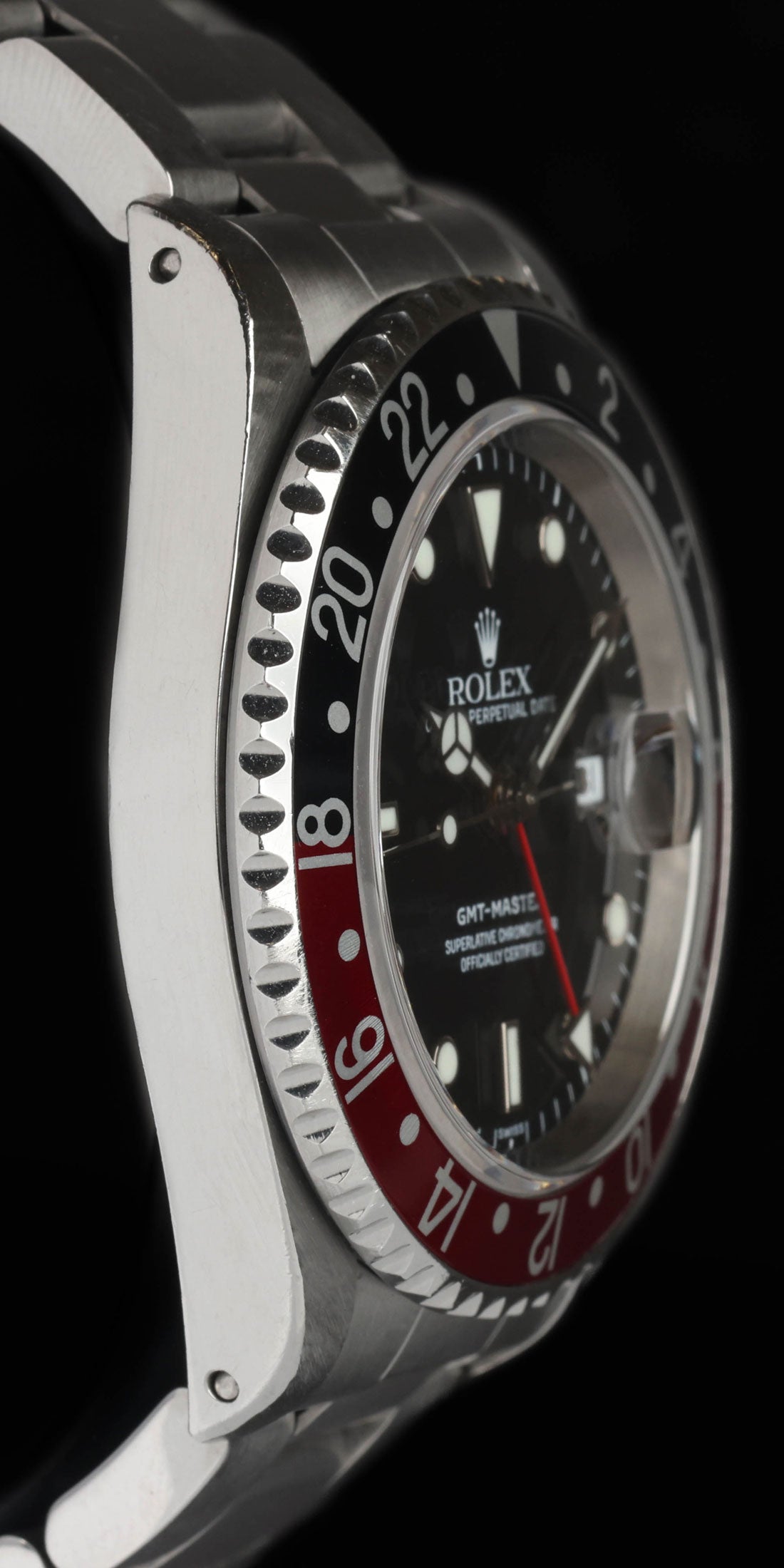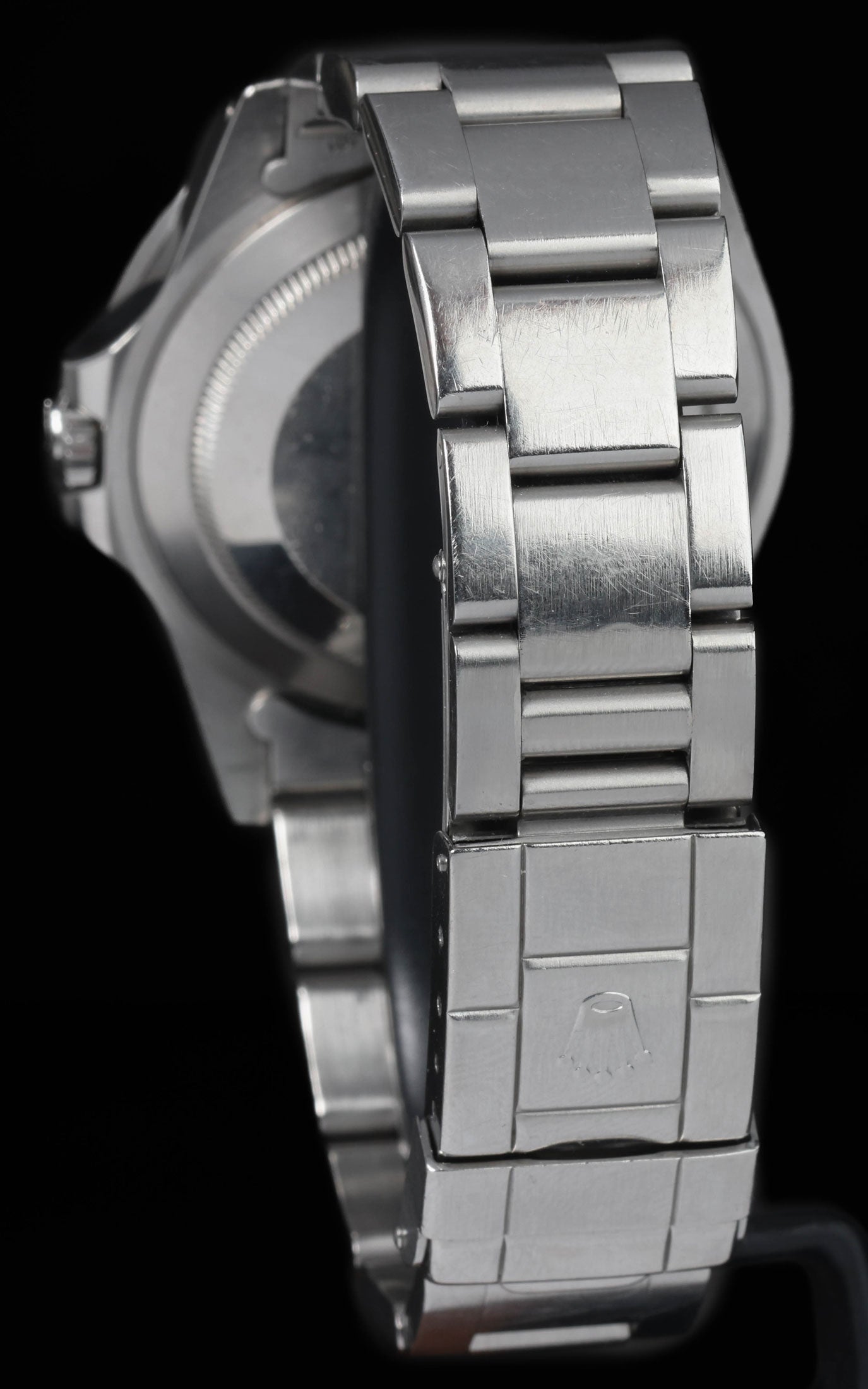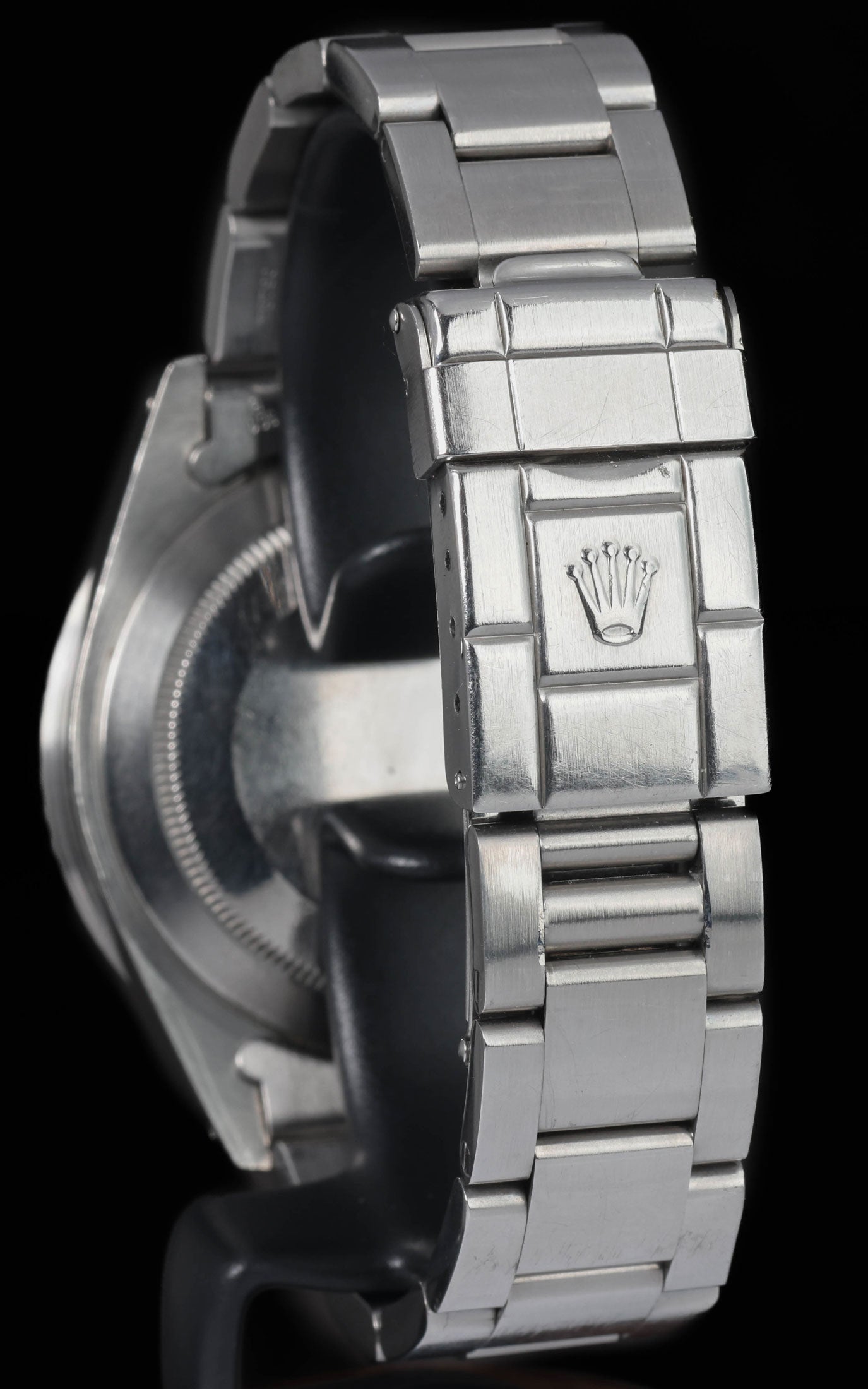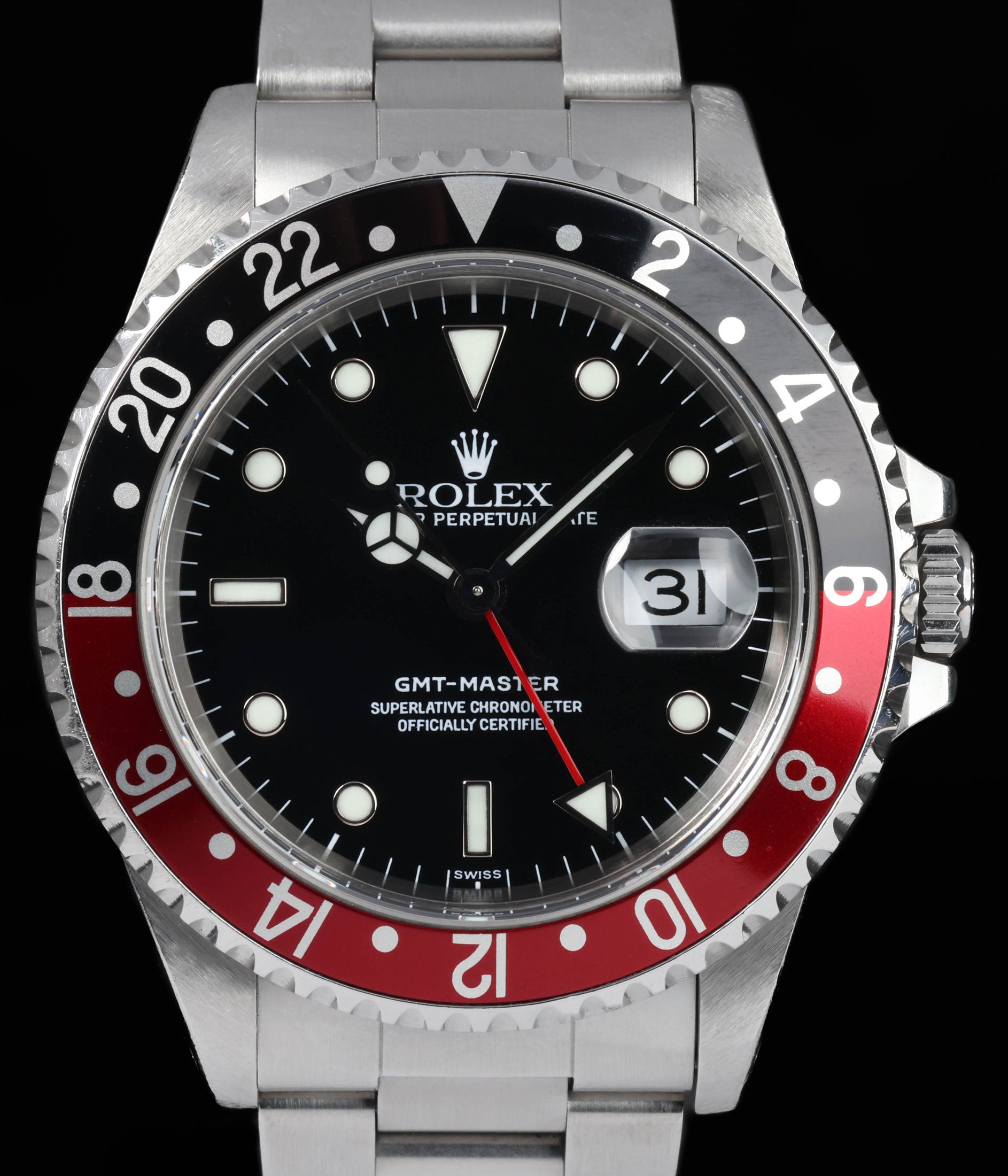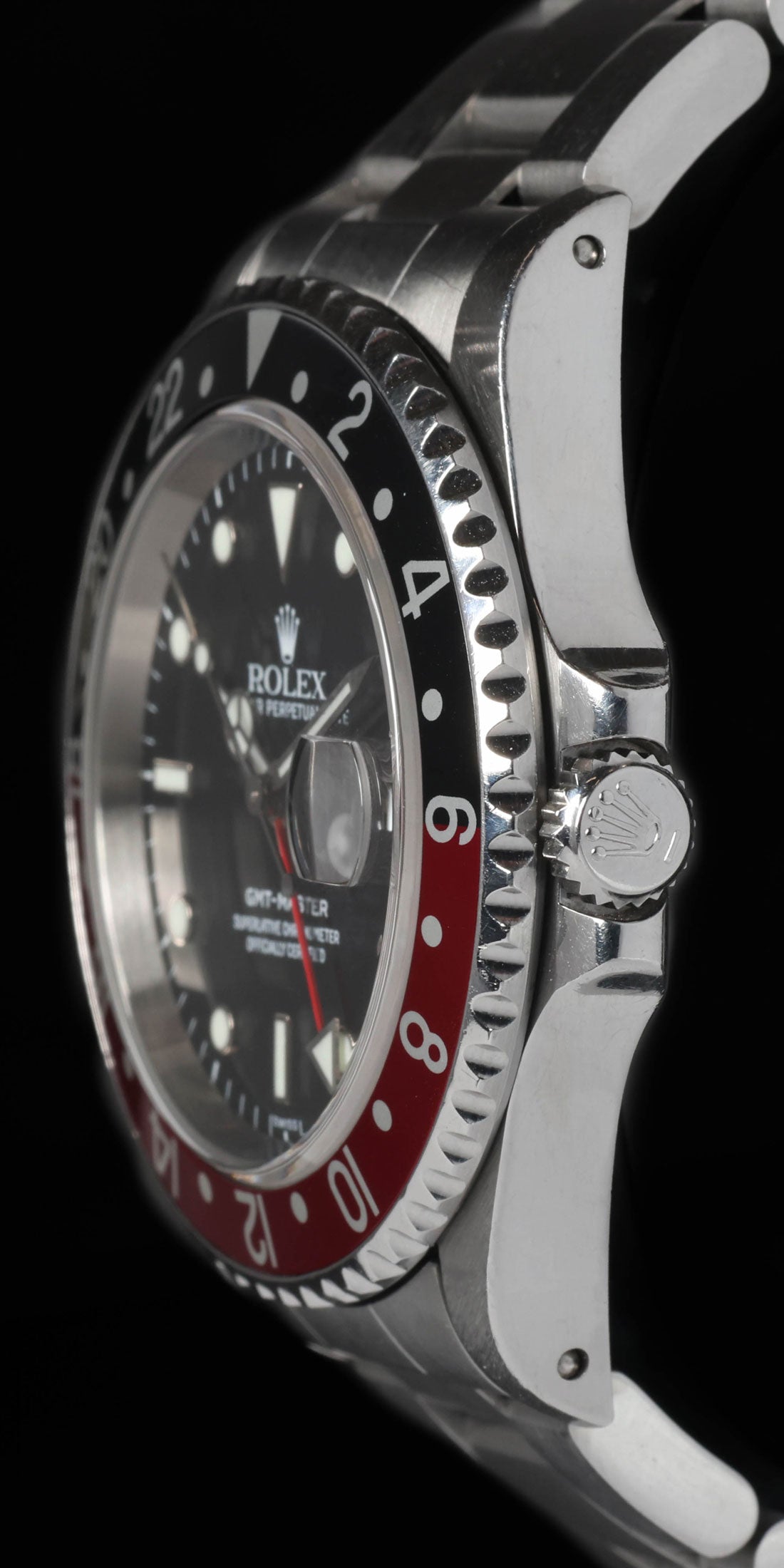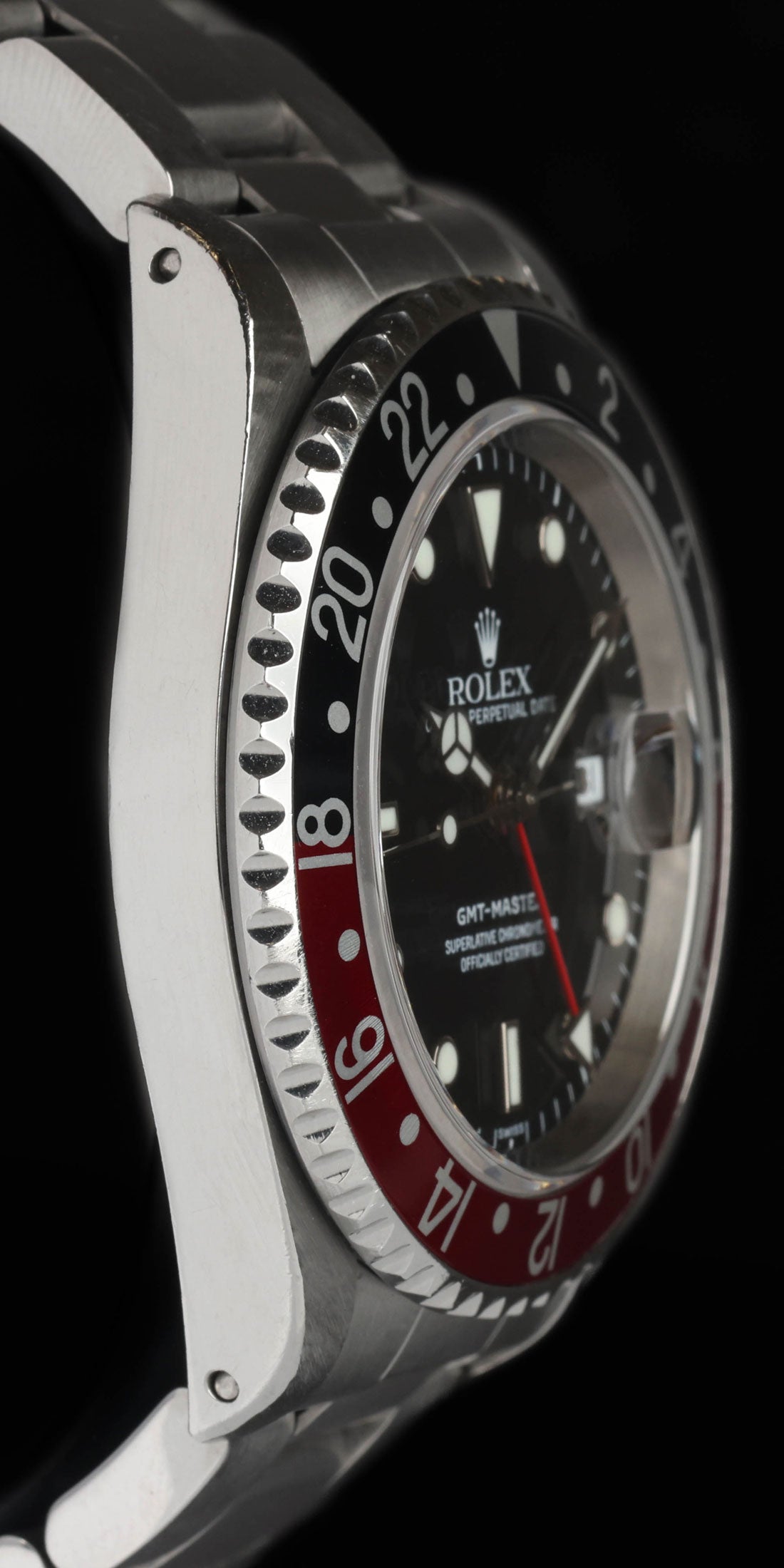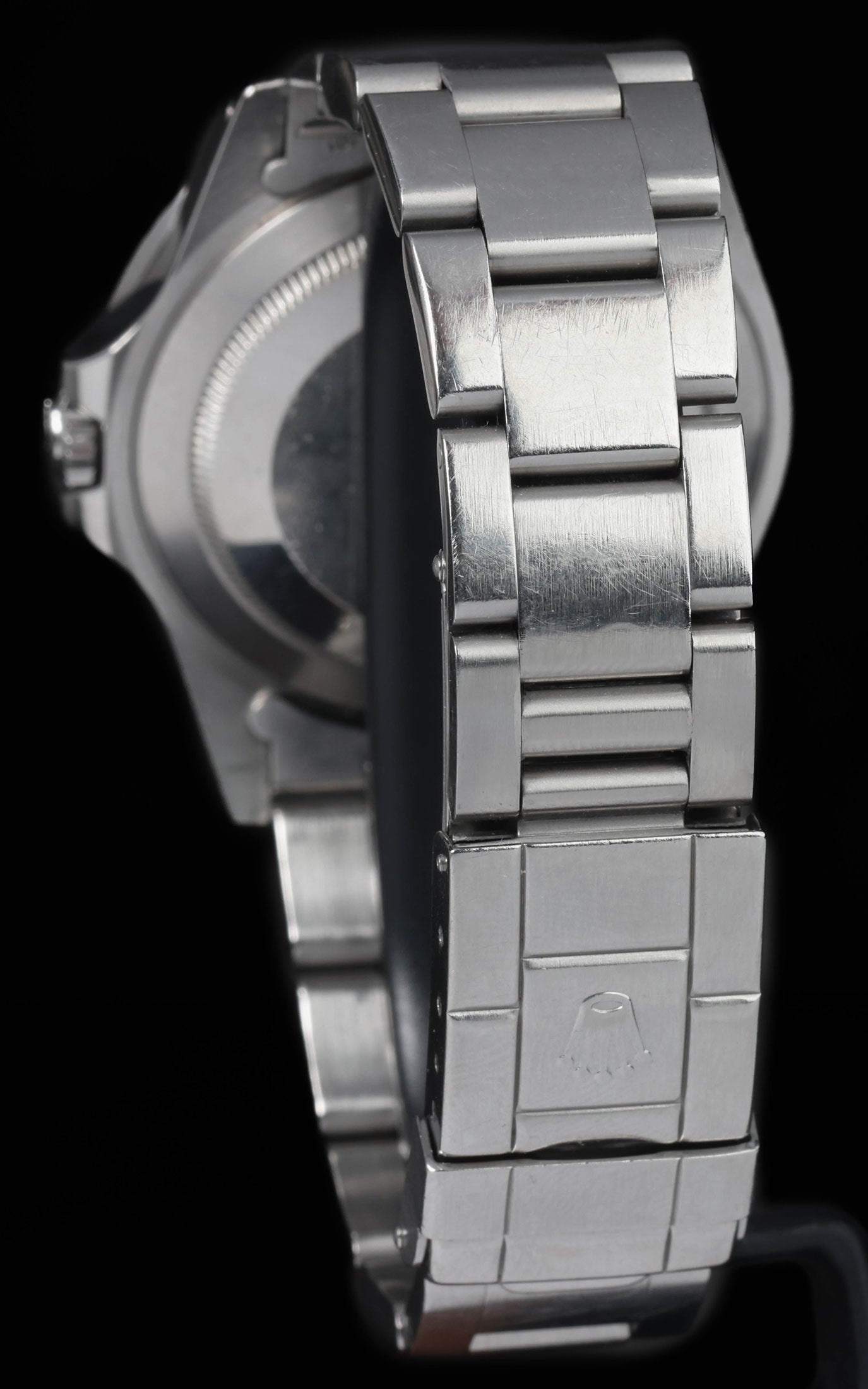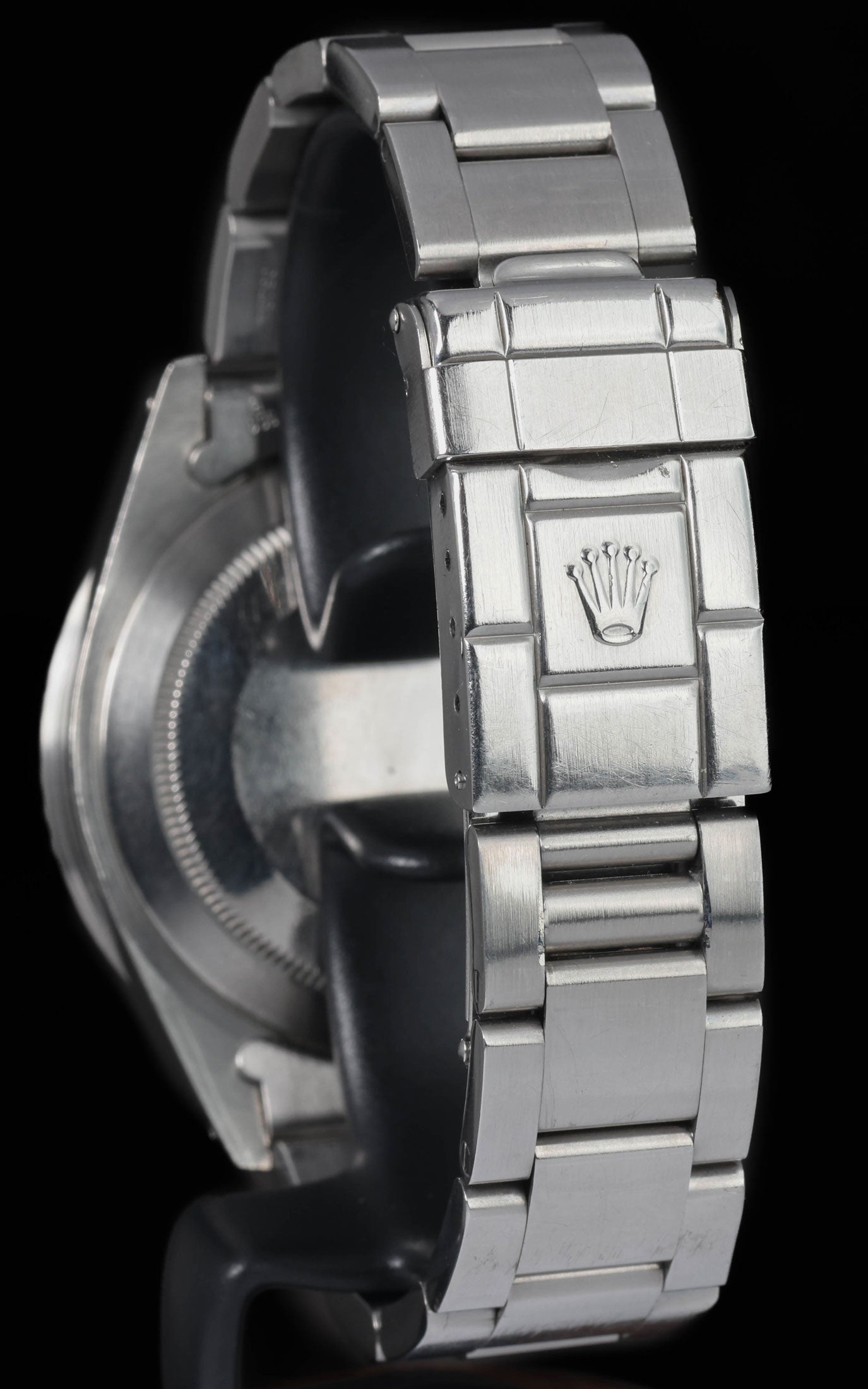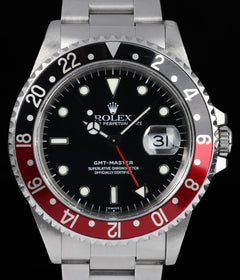Crown Vintage
Rolex GMT Master 16700 'Swiss Only' Coke 40MM 1999
Rolex GMT Master 16700 'Swiss Only' Coke 40MM 1999
Couldn't load pickup availability
Rolex GMT Master 16700 'Swiss Only' Coke
This Rolex GMT-Master 16700 presents in overall great condition. The stainless steel case remains sharp and well-defined, with crisp lug edges and light hairline scratches visible upon close inspection. The original finishing is well preserved, indicating careful wear. The Oyster bracelet is in good condition, showing surface hairlines throughout but retaining solid integrity and a clean appearance. Stretch is minimal, and the clasp closes securely. The black dial is in excellent condition, with luminous hour plots that remain clean and well preserved. The hands are similarly excellent, with no signs of corrosion or degradation. The red and black aluminium bezel insert is vibrant, completing a strong example of this late-production reference.
Share
Why we love this watch
Why we love this watch
Rolex GMT-Master 16700 ‘Swiss Only’ Coke 40MM from 1999: A Transitional Icon
Introduction
The Rolex GMT-Master reference 16700 holds a special place in the evolution of Rolex’s iconic dual-time sports watch. Produced from 1988 until 1999, it was the last reference to carry the original GMT-Master name before the brand shifted focus entirely to the GMT-Master II line. In its final year of production, a transitional dial variant appeared—marked simply “Swiss” at 6 o’clock—signalling a quiet shift in luminous material from tritium to LumiNova.
This subtle change coincided with the conclusion of the reference’s production run, making late examples fitted with this dial a compelling footnote in the brand’s broader design history. Paired with the bold red and black “Coke” bezel insert, the 16700 from 1999 captures the very last breath of the original GMT-Master concept before it was replaced by a new generation of more complicated travel watches.
The Origins of the GMT-Master
The GMT-Master was born in the mid-1950s, developed in collaboration with Pan Am Airways to address the emerging needs of intercontinental pilots. The reference 6542 launched the line in 1955 with a Bakelite bezel and no crown guards. That watch would be short-lived but quickly succeeded by the reference 1675 in 1959, which introduced key design traits—crown guards, a rotating aluminium bezel, and more durable construction—that would define the GMT-Master for the decades that followed.
Through the 1970s and 80s, the GMT-Master remained one of Rolex’s flagship tool watches. Originally designed for cockpit use, it gradually gained popularity with frequent travellers and sports watch buyers thanks to its clean layout, multiple time zone capability, and enduring style.
Enter the 16700
In 1988, Rolex launched the reference 16700 as a successor to the 16750. It retained the core architecture and layout of earlier GMTs but updated the movement to the Calibre 3175, offering hacking seconds and a quickset date. Importantly, this model remained true to the original GMT format, using a fixed 24-hour hand and rotating bezel to track a second time zone.
By the late 1980s, the GMT-Master II had already made its debut with the reference 16760, boasting a new movement that allowed the hour hand to be set independently. While more flexible for travellers, the GMT-Master II was a more complex watch. Rolex, therefore, continued to offer the simpler GMT-Master in parallel—more affordable, less complicated, and lighter on the wrist.
The 16700 remained in production for over a decade with relatively few design changes. Early models featured tritium lume and a choice of Pepsi (red and blue) or Coke (red and black) bezel inserts. As production wound down in 1999, the final batch was fitted with a dial using LumiNova and signed simply “Swiss” at the bottom. These late examples subtly mark the end of the line for the original GMT-Master series.
Design and Case
The 16700 was housed in a 40mm stainless steel Oyster case with a slim profile and drilled lug holes. At approximately 12mm thick, it is thinner and more wearable than the GMT-Master II models that would follow. It came fitted with a sapphire crystal and a 100m water resistance rating, making it durable enough for everyday use without losing its aviation-inspired elegance.
The aluminium bezel insert, finished in black and red, gives the watch its “Coke” nickname. The colour split not only adds visual contrast but enhances practical function—helping distinguish between daytime and nighttime hours on the 24-hour scale. Unlike the more common Pepsi version, the Coke bezel gives the watch a more grounded and modern look, especially when paired with the brushed steel Oyster bracelet.
The bezel itself is bidirectional and easy to manipulate, with precise clicks and a practical feel. Unlike modern ceramic inserts, aluminium fades over time, often developing unique patina that gives each watch a distinct character.
Dial and Layout
The dial design on the 16700 is pure Rolex: matte black, luminous hour plots set in white gold surrounds, and minimal text. The familiar triangle marker at 12 o’clock, along with rectangular and circular plots, ensures quick orientation at a glance—a necessity in aviation environments.
The 1999 dial uses LumiNova instead of tritium, a material transition that Rolex rolled out across its range during the late 1990s. The switch brought better glow performance and eliminated radioactive material. Unlike later dials signed “Swiss Made,” these final examples only bear the single word “Swiss” at 6 o’clock, a subtle marker of this brief transition period.
The hands are the classic GMT combination: Mercedes hour hand, sword minute hand, red 24-hour hand with an arrow tip, and a long seconds hand with a luminous circle. The date sits at 3 o’clock, magnified by a Cyclops lens for legibility.
Overall, the dial is clean, symmetrical, and highly functional, offering perfect legibility without clutter. It’s a look that has endured because it works—whether crossing time zones or worn casually on the weekend.
Movement: Calibre 3175
The 16700 is powered by Rolex’s Calibre 3175, a self-winding movement based on the proven 3000-series architecture. It operates at 28,800 beats per hour and features a quickset date, hacking seconds, and around 48 hours of power reserve.
Unlike the 3185 used in the GMT-Master II, the 3175 does not offer independent hour hand adjustment. This keeps the movement simpler and, in some ways, closer to the original GMT design concept. By rotating the bezel in combination with the fixed 24-hour hand, the user can still track a second time zone effectively.
The movement is robust, reliable, and has a reputation for excellent timekeeping when serviced properly. While not visible through the caseback, it represents Rolex’s focus on practical, dependable engineering.
Bracelet and Wearability
The 16700 typically came fitted with the Oyster bracelet reference 78360, featuring solid outer links, hollow centre links, and a stamped folding clasp. The end links (501B) are also hollow, giving the bracelet a light, flexible feel on the wrist. Some examples were fitted with Jubilee bracelets, but the Oyster is more commonly associated with the sportier Coke variant.
With a 40mm case and slim profile, the 16700 wears comfortably on most wrists. The drilled lug holes make strap changes quick and easy, offering flexibility for those who like to switch between steel, rubber, or leather.
The weight, proportions, and case shape of this watch give it a balanced, satisfying presence—large enough to feel purposeful, but not oversized by modern standards.
Differentiating the 16700 from the 16710
Because the 16700 and 16710 coexisted for much of the 1990s, they are often compared. However, their differences are more than just mechanical:
- Movement: The 16700 uses the simpler Calibre 3175, whereas the 16710 features the more complex Calibre 3185 with an independently adjustable hour hand.
- Bezel: Both offered Pepsi and Coke inserts, but the all-black insert was exclusive to the 16710.
- Dial Text: The final dials on the 16700 featured the single-word “Swiss,” while the 16710 transitioned earlier to “Swiss Made” once Super-LumiNova was adopted.
- Production Run: The 16700 ended production in 1999, while the 16710 continued until 2007, undergoing several updates along the way.
The 16700’s appeal lies in its simplicity—faithful to the original GMT design and free from the added complexity of modern dual-time movements.
Rarity and Appeal
Because Rolex produced the 16700 for a shorter time and in fewer variations than the 16710, it has become increasingly appreciated among those who value transitional models. The final-year examples with LumiNova dials are especially interesting, offering a short-lived dial configuration that differs from earlier tritium models yet predates the “Swiss Made” layout now found on all modern Rolex dials.
When paired with the red and black bezel, this version feels both grounded and distinct—less common than the Pepsi GMTs, yet just as recognisable in silhouette. Its neo-vintage appeal is enhanced by the presence of drilled lugs, hollow links, and a case profile that Rolex no longer offers.
Final Thoughts
The Rolex GMT-Master 16700 with a Swiss dial and Coke bezel insert from 1999 represents the closing chapter of a historic reference line. It is the last model to carry the original GMT-Master name, the final version before Rolex phased out the simpler dual-time format, and one of the only versions to feature LumiNova without the now-standard “Swiss Made” dial marking.
What makes it truly compelling is its understated complexity. At first glance, it appears like any other GMT-Master from the 1990s—but upon closer inspection, it reveals itself as a transitional reference: the end of tritium, the end of the GMT-Master name, and the last moment before Rolex ushered in the era of ceramic bezels, solid end links, and more refined cases.
For those who appreciate Rolex design at its most balanced—where tool-watch utility meets understated charm—the 16700 from 1999 offers something few other references can: a clear link to the past, preserved at the very edge of modernity.
Case & Bracelet
Case & Bracelet
- Case in great condition, very sharp lugs with light hairlines visible.
- Bracelet in good condition, light hairline scratches visible.
- Bracelet has minimal stretch.
Dial & Hands
Dial & Hands
Dial & hands excellent condition.
Warranty & Condition
Warranty & Condition
Crown Vintage Watches provides a minimum 3-month mechanical warranty on pre-owned watches, from the date of purchase.
The warranty covers mechanical defects only.
The warranty does not cover damages such as scratches, finish, crystals, glass, straps (leather, fabric or rubber damage due to wear and tear), damage resulting from wear under conditions exceeding the watch manufacturer’s water resistance limitations, and damage due to physical and or accidental abuse.
Please note, water resistance is neither tested nor guaranteed.
Shipping and insurance costs for warranty returns to us must be covered by the customer. Returns must be shipped via traceable courier. Return shipment must be pre-paid and fully insured. Collect shipping will be refused. In case of loss or damages, the customer is liable.
Our Pledge
At Crown Vintage Watches, we stand by the authenticity of every product we sell. For added peace of mind, customers are welcome to have items independently authenticated at their own expense.
Condition
Due to the nature of vintage timepieces, all watches are sold as is. We will accurately describe the current condition and working order of all watches we sell to the best of our ability.
Shipping & Refund
Shipping & Refund
